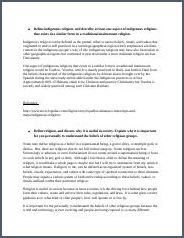
Indigenous breeds are unique breeds of animals that have been bred for centuries in specific geographic areas. These breeds are often associated with specific cultures and traditions, and are often used for livestock or other agricultural purposes.
Indigenous breeds are often particularly well-suited to specific environmental conditions, and are often difficult to find outside of their original geographic areas. Many of these breeds are threatened or endangered, and efforts are being made to protect them and preserve their unique genetic heritage.
Contents
Define Indigenous Breed
An Indigenous Breed is a species of animal or plant that is native to a particular geographic region. It is important to note that they are often threatened by human activities such as habitat destruction, hunting, and pollution. Indigenous Breeds are often genetically distinct from other species, and contain unique traits that are adapted to their local environment, making them incredibly valuable to biological diversity. Indigenous Breeds are often considered the “original” breed of a species and are highly sought after for their unique characteristics. Conservation efforts are often implemented to protect and conserve these breeds, as without them, entire species can be lost forever.
Definition of Indigenous Breeds

Indigenous breeds are those breeds of animals or plants that have a distinct genetic heritage or origin, and are native to a particular area of the world. These breeds are often adapted to their local environment, and typically have a long history of domestication and use. Indigenous breeds are often considered to be an integral part of a region’s cultural heritage, and have been heavily relied upon by local communities for centuries.
Indigenous breeds are usually distinct from modern breeds and hybrid varieties, which are the result of selective breeding techniques used to produce specific traits. These techniques are often employed by breeders to increase the size, fertility, and hardiness of certain animals or plants. Indigenous breeds, on the other hand, have evolved naturally in their local environment, and are usually well adapted to their surroundings. Their genetics are often unique, and are often much more diverse than those of modern breeds.
Indigenous breeds also tend to be more resilient than modern breeds, as they have adapted to the specific environment in which they live. This gives them a higher resistance to disease and parasites, as well as greater tolerance for extreme temperatures. Indigenous breeds also tend to be more productive than modern breeds, as they have been bred for longer and are better suited to their local environment. Furthermore, the genetics of indigenous breeds are often more diverse, allowing for greater genetic diversity, which can be beneficial for future breeding practices.
In addition to their unique genetic heritage, indigenous breeds also have an important cultural value. Many indigenous breeds are deeply embedded in the culture of their respective regions, and are often seen as symbols of a community’s identity and heritage. These breeds are often integral to the local economy, as they are used for food, medicine, and even companionship. By protecting these breeds from extinction, we can ensure that the cultural values of these communities are preserved for generations to come.
Characteristics of Indigenous Breeds
Indigenous breeds, otherwise known as "native breeds," are a unique type of domesticated animal that have been bred in a specific region for centuries, often with little or no outside influence. Indigenous breeds are highly adapted to their native environment and are often prized for their hardiness, temperament, and adaptability. They are also often capable of surviving in harsh climates and resist diseases better than their non-native counterparts.

The characteristics of indigenous breeds vary greatly depending on the breed. Some common traits among these breeds include a high level of intelligence, loyalty, and an independent nature. They are also typically very resilient and can withstand extreme temperatures, harsh weather conditions, and challenging terrain. These breeds are often highly sought after as pets and working animals due to their loyalty and adaptability.
Indigenous breeds have evolved over time to become better suited to their native environment. They have developed traits that allow them to survive in harsh climates, such as short coats and a resistance to disease. They are also extremely hardy, able to survive on limited amounts of food and water, and they tend to be very social animals.
These breeds also tend to be loyal and protective of their owners and are often used as working animals. They are highly trainable and can be used for a variety of tasks, including herding and guarding. They are also great companions, forming strong bonds with their owners and exhibiting a strong desire to please.
Overall, indigenous breeds are a unique type of domesticated animal with a variety of unique characteristics. They are highly adapted to their native environment and tend to be incredibly resilient and adaptable. They are highly sought after as pets and working animals due to their loyalty and intelligence, and are often capable of surviving in harsh climates and with limited resources.
Examples of Indigenous Breeds
When we talk about “indigenous breeds”, we’re referring to breeds of animals that are native to a particular region. These breeds are found in their native countries, with little to no outside influence on their development. They are usually adapted to local climate and environment, and generally have a long history in their native region.

Indigenous breeds have been around for centuries, and as such, have developed a range of unique characteristics that are adapted to the local environment. They are typically hardier and more resilient than breeds developed outside of their native region, and often have a unique look or behavior that is specific to their region.
Some examples of indigenous breeds include the longhorn cattle of Texas, the Morgan horse of the United States, the Mangalarga Marchador of Brazil, and the Yakut Pony of Siberia. These breeds are all adapted to the climate, terrain, and environment of their native regions, and have evolved to suit their local conditions.
In addition to these well-known breeds, there are also many more that are lesser-known but no less important. The Barbari goat of India, the Orlov Trotter horse of Russia, and the Barb of Barbados are all examples of indigenous breeds that are each unique to their region.
Indigenous breeds are important to the local communities where they live, and can contribute to the local economy. They can be used for a variety of tasks, from providing milk and meat, to being used for work and transportation. They are also an important part of preserving the culture, history, and identity of the local communities, and serve as a reminder of where they come from.
Ultimately, indigenous breeds are an important part of the world’s biodiversity, as they are a unique and irreplaceable part of the natural environment. They are a valuable resource for local communities, and should be valued and protected.
Conclusion
Based on the definition provided, an indigenous breed is a type of animal that is native to a particular region or country. These animals have typically been bred in that area for many generations, and are well-adapted to the local climate and environment. Indigenous breeds are often well-suited to the local diet and lifestyle, and can be an important part of the cultural heritage of a region.




